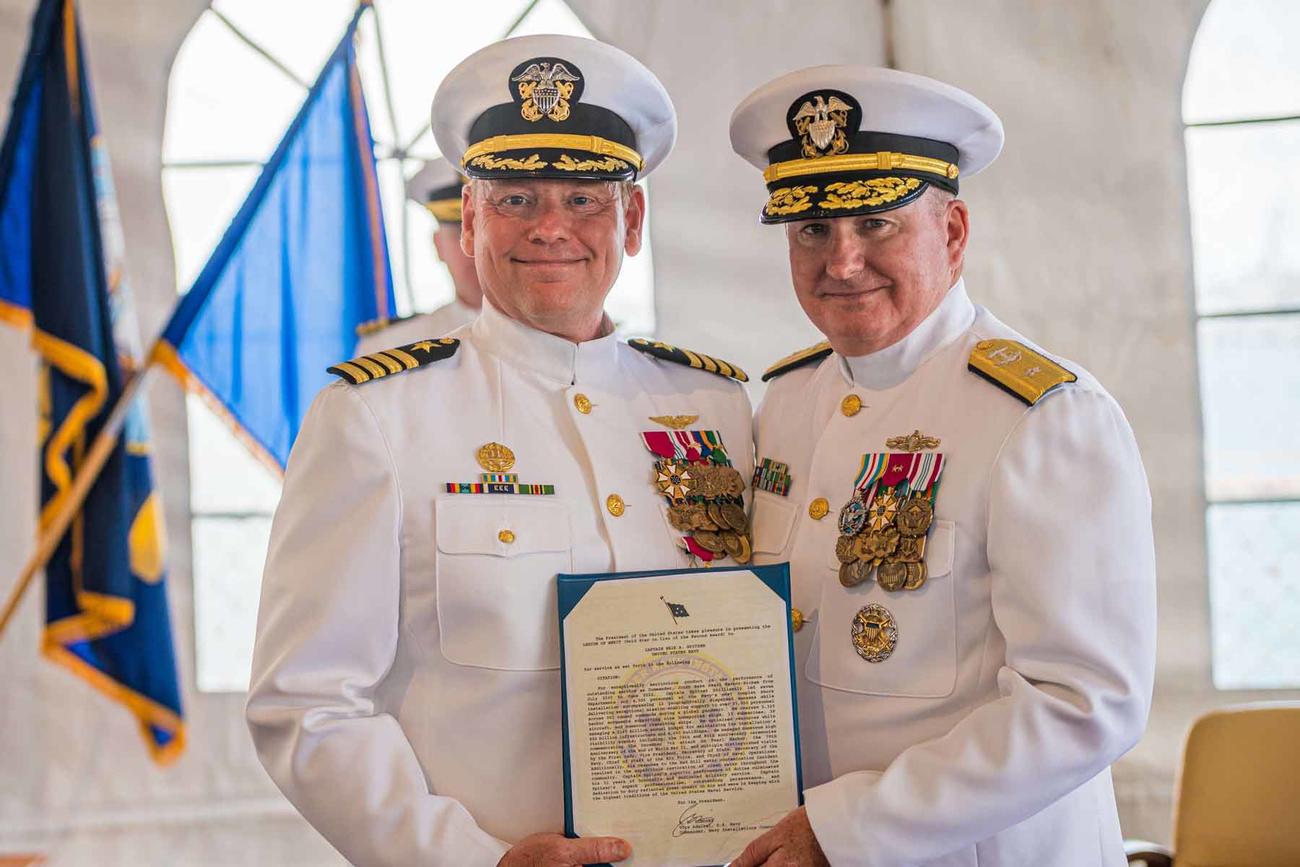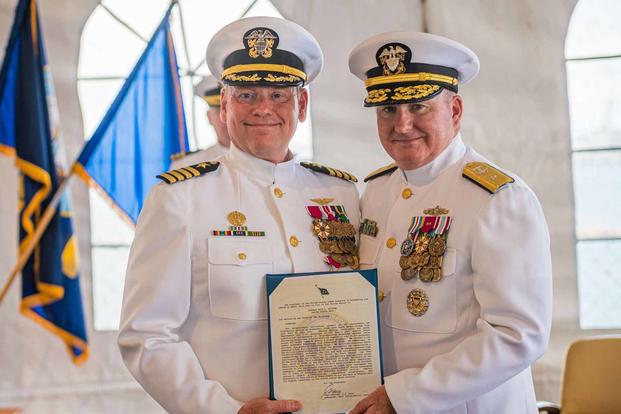

The Navy commanding officer who led Joint Base Pearl Harbor-Hickam through the second-worst known case of water contamination in military history retired last month, earning the Defense Department’s second-highest non-combat service award in the process.
More than seven months after the disastrous and preventable spill that displaced thousands of base residents — and as the Navy has yet to announce who, if anyone, will be held accountable — Capt. Erik Spitzer was awarded the Legion of Merit for his work at the base over the past two years.
The Navy’s World War II-era Red Hill Bulk Fuel Storage Facility accidentally released thousands of gallons of fuel and water into a tunnel that houses a fire suppression system drain line, resulting in the contamination of a nearby drinking water well that serves Pearl Harbor.
Read Next: 2,000 Expert Soldier Badges Have Been Awarded in 3 Years. But Do Non-Combat Units Want It?
The spill sickened hundreds of military families living on or near the installation, forcing them to rely solely on bottled water in their homes or to live in hotels for several months while the Navy worked to flush the lines and restore safe drinking water.
Spitzer, who received his award aboard the historic battleship USS Missouri, was congratulated for “his response to the Red Hill water contamination incident,” which “resulted in the expeditious restoration of clean water throughout the community,” according to the award’s citation, which was visible in photos of the event.
The investigation found that poor management and oversight, as well as a questionable response by the Navy, led to the crisis, resulting in hundreds of residents needing to seek medical care and dispose of any household items that came into contact with the fuel-contaminated water.
But the investigation also found that a construction error in 2015 — the choice to use PVC pipe rather than steel pipe for the facility’s fire suppression system — contributed to the system’s massive failure.
The medal is a common award given to high-ranking officers upon the completion of a duty tour. It was Spitzer’s second. As commanding officer of Pearl Harbor, he was responsible for the safety, security, environmental stewardship and protection of personnel and property on the installation.
However, the praise stands in contrast to Spitzer’s actions in the days after the spill and reports of chemical smells in the drinking water on base.
‘Deeply Remorseful’
On Nov. 29, 2021, Spitzer told residents “that there are no immediate indications that the water is not safe,” adding that “my staff and I are drinking the water on base this morning, and many of my team live in housing and drink and use the water as well.” The next day, though, the Hawaii Health Department advised residents to avoid drinking or using the water in any way.
On Dec. 5, Spitzer publicly apologized for trusting the initial test results and misleading the sailors and families living on base.
“If there was one day I had a chance to do over, it would be that day,” he wrote in the December statement. “We truly thought the testing results indicated the water was safe to drink. We were wrong.
“I regret I did not tell our families not to drink the water. I am deeply remorseful,” the message said.
The subsequent investigation, which was released last week, painted a complex picture of offices and officials who had a hand in running both the fuel storage facility, as well as the well of drinking water for the base. In the mix was the Navy’s Chief of Naval Installations – they owned the well — and the Facilities and Engineering Command, which operated the well. Plus, there were public works officers, members of the Utilities and Energy Management office, and others who could have ordered the drinking water shut off in the wake of the spill.
The report found that the Navy created a situation where there was “no single Red Hill owner per se,” but it also noted that Spitzer was the single individual who held the “authority and accountability to act comprehensively and decisively” because he was deemed the incident commander when the crisis at Red Hill unfolded.
“He did not exercise his unique authority, and that inaction contributed to contamination of the drinking water because the response was neither comprehensive nor effective,” the report added.
Furthermore, the report said that Spitzer’s message to residents was one of four “key friction points” that “negatively impacted public trust in the Navy.”
Military.com has reached out to the Navy for comment on Spitzer’s award but did not hear back before publication.
Since turning over his command of the Pearl Harbor base, Spitzer is in the process of retiring from the Navy this month.
An Earlier Spill and the Wrong Pipe
The investigation found that the Navy’s lack of a response to an earlier spill in May 2021 and the November 2021 spill contributed to the contamination of the drinking water supply, and that human error throughout the process led to the displacement of thousands from their homes.
But the November spill might not have happened if the Red Hill Bulk Fuel Facility’s fire suppression system had been built as originally specified in 2015, with steel pipe instead of PVC, the investigation found.
According to the investigation released June 30 by the Navy, the spill occurred when a worker, known as a rover, accidentally struck a fire suppression system retention line with his vehicle, cracking the PVC pipe and causing a joint to rupture.
The accident sent thousands of gallons of liquid, including JP-5 jet fuel, gushing into the tunnel, as seen in video and photos obtained by the Hawaii-based media outlet Civil Beat.
Workers did not realize that the line was contaminated with fuel from an earlier spill that occurred in May during fuel transfer, according to the investigation. The May 6 event released roughly 20,000 gallons into the area.
Navy officials underestimated the scope of that spill, leading them to believe that most of the fuel had been contained. But the November accident released fuel from the earlier spill, causing up to 5,542 gallons of fuel to leak into the ground, the porous concrete flooring and drain, eventually leaching into the drinking water well.
The fire suppression system’s retention lines never were meant to be PVC piping. They were to be steel, according to Navy Facilities Command Pacific and the system’s designer. Steel is much sturdier than PVC pipe, less susceptible to cracks and exterior damage, and more resistant to chemical breakdown when exposed to fuel or other contaminants.
According to the investigation, the actual plans for the system called for steel pipes. A switch was made when the construction contractor, Hensel Phelps, asked the Navy for clarification on the plans, having interpreted the drawings and specifications to show that it was to use PVC.
In response, a construction manager contracted by the Navy approved the decision to use PVC, telling Hensel Phelps to proceed, so the company installed the plastic pipes.
The investigation noted that there was ample time to change the materials during construction. According to the report, the builders submitted purchase requests for PVC pipe and later asked whether the system needed a containment “jacket” around the piping to ensure that contents could be contained in the event of a break.
Hensel Phelps issued a statement Friday to Military.com saying it installed the system to design specifications, maintaining that the plans called for PVC pipes to carry foam fire suppressant.
“Hensel Phelps installed the fire alarm/fire suppression system in compliance with the design issued to Hensel Phelps from the government,” the company said in a statement.
While investigators largely attributed the disaster to human error, they added that the PVC piping was also a cause of the November spill.
“It is reasonable that steel pipe … would have been less likely to sag under the weight of fuel contained within it, making it unlikely that the trolley would have struck the low point drain valve in that case. Even if struck by the trolley in the same manner as actually occurred, a steel retention line and low point drain would most likely not have ruptured, thereby preventing the spill,” the report stated.
— Konstantin Toropin can be reached at [email protected]. Follow him on Twitter @ktoropin
— Patricia Kime can be reached at [email protected]. Follow her on Twitter @patriciakime
© Copyright 2022 Military.com. All rights reserved. This material may not be published, broadcast, rewritten or redistributed.
